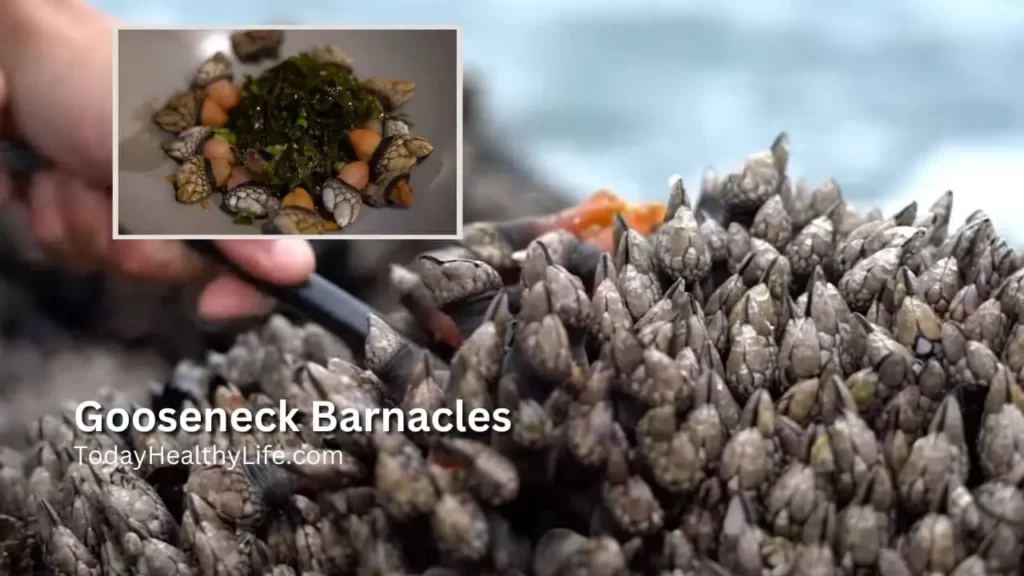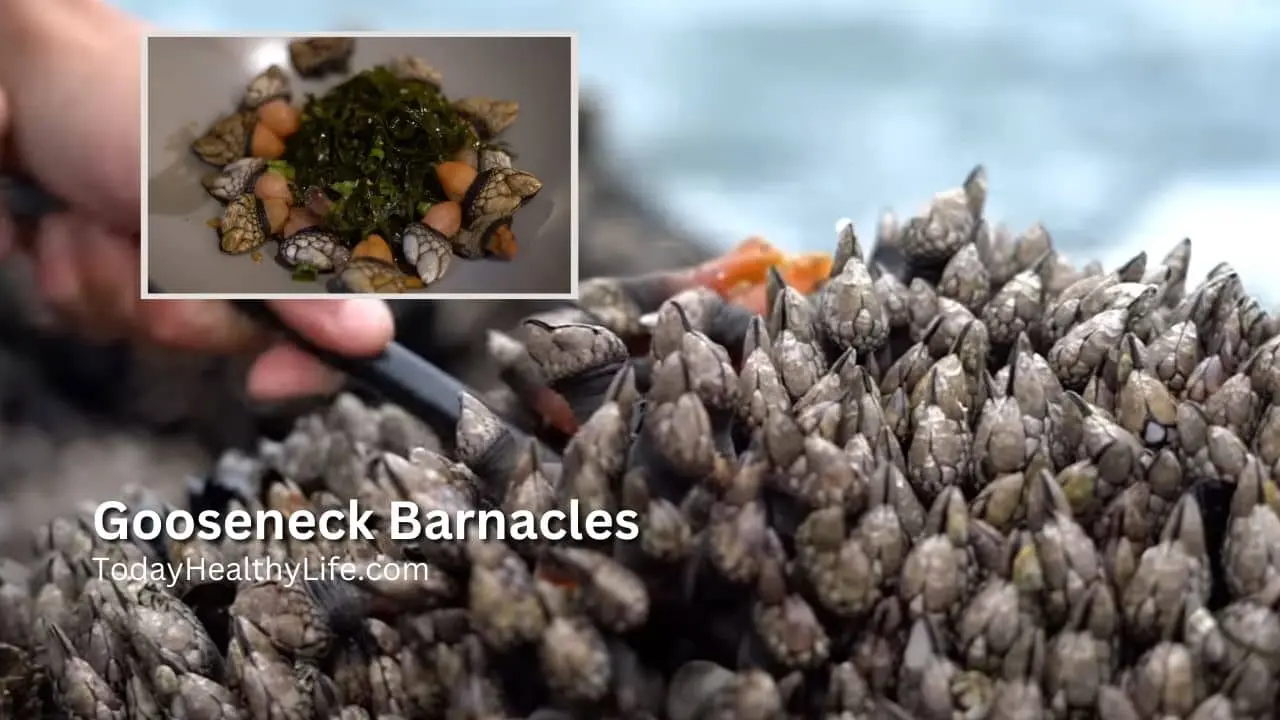Do you know why are gooseneck barnacles dangerous?
When you think of dangerous marine animals, what comes to mind? Sharks? Jellyfish? Octopi?
While all of these creatures can be harmful, there is one animal that often goes overlooked – the gooseneck barnacle. These small invertebrates may not look like much, but they can do some serious damage.
In this post, we’ll take a closer look at why gooseneck barnacles are dangerous and how to stay safe around them.

Table of Contents
What is a gooseneck barnacle?
Gooseneck barnacles are small invertebrates that belong to the genus Lepas.
They are often found attached to a hard substrate, such as rocks or other animals, and can be recognized by their distinctive “gooseneck” appendages.
These appendages have sharp points on the end that can cause painful injuries if they come into contact with skin.
Also Read:
- Gooseneck Barnacles: Teste, Benefits, Side Effects, Nutrition & All.
- Gooseneck Barnacles Recipe, Or How To Eat Goose Barnacle?
- What Are the Disadvantages of Snakes?
Why are gooseneck barnacles dangerous?
Gooseneck barnacles are not dangerous to eat, but they are dangerous to harvest. They are typically found on the rocks of high-energy coastlines, such as cliffs and headlands.
This means that the harvesters must climb down the cliffs and collect the barnacles during low tide, when the water is only a few feet deep.
The danger comes from the fact that the tides can come in very quickly, and the harvesters can be swept off the rocks and drowned.
In fact, there have been many deaths of percebeiros, as they are known, over the years.
In addition to the danger of the tides, harvesters also risk being injured by the barnacles themselves. The gooseneck barnacles have long, sharp spines that can easily pierce the skin. If a harvester is not careful, they can be seriously injured.
For these reasons, harvesting gooseneck barnacles is considered to be a very dangerous occupation. Only the most experienced and skilled harvesters will attempt it.
Are gooseneck barnacles dangerous to eat?
No, gooseneck barnacles are not dangerous to eat if they are properly cleaned and cooked.
There have been no recorded cases of illness or infection associated with consuming these barnacles, so it is generally considered safe to eat them in moderation.
However, there are a few things to keep in mind:
- Only eat barnacles that have been harvested from clean waters. Barnacles can filter-feed on pollutants, so it is important to make sure that the barnacles you eat have not been exposed to harmful chemicals.
- Clean the barnacles thoroughly before cooking. This will help to remove any dirt or debris that may be present.
- Cook the barnacles until they are opaque. This will help to kill any harmful bacteria that may be present.
If you follow these simple guidelines, you can enjoy gooseneck barnacles safely and enjoy their delicious taste.
Here are some additional tips for eating gooseneck barnacles:
- Serve them with a simple vinaigrette or lemon juice dressing. This will help to bring out their natural flavor.
- Garnish them with fresh herbs, such as parsley or chives. This will add a touch of freshness.
- Pair them with a white wine or a light beer. This will help to complement their briny flavor.
I hope this helps!
How can you stay safe around gooseneck barnacles?
The best way to protect yourself from gooseneck barnacles is to stay vigilant when swimming or recreating in shallow areas near the coast.
Always wear protective clothing, such as wetsuits, gloves, and boots.
Avoid swimming or walking barefoot in these areas, and if you do get injured by a gooseneck barnacle, be sure to wash the wound thoroughly with clean water and seek medical attention if necessary.
If you love spending time in coastal waters, it’s important to be aware of the dangers posed by gooseneck barnacles.
By taking simple precautions and following these safety tips, you can enjoy your time on the water without worrying about getting injured.
What are the best ways to collect gooseneck barnacles?
There are a few different methods that you can use to collect gooseneck barnacles.
One approach is to simply knock them off of rocks and other surfaces using a hammer or similar tool, which allows you to gather the barnacles without needing specialized equipment.
Alternatively, you can use special traps or barriers to trap the barnacles as they attach to a surface, and then remove them safely with tweezers or scrapers.
As long as you follow safety precautions when collecting gooseneck barnacles, such as wearing gloves to avoid cuts and irritations, you should be able to successfully gather these interesting creatures for yourself.
Here are some additional safety tips for harvesting gooseneck barnacles:
- Always harvest during low tide.
- Wear sturdy shoes with good traction.
- Be aware of the tides and the time it takes to climb back up the cliff.
- Have a partner with you in case of an emergency.
If you are considering harvesting gooseneck barnacles, be sure to weigh the risks and rewards carefully. It is a dangerous occupation, but the rewards can be great.
Are there any safe ways to remove gooseneck barnacles from your skin or other surfaces?
To remove from your skin
There are a number of different methods that people use to remove gooseneck barnacles from the skin or other surfaces.
These include scraping them off with a sharp object such as a knife or razor, immersing the affected area in hot water for several minutes, and using chemical solvent creams.
However, it is generally recommended to consult a medical professional before attempting to remove gooseneck barnacles from your skin, as improper removal techniques can cause further injury and infection.
Some methods, such as scraping and chemical creams, require medical supervision.
Always follow the instructions of your doctor or other medical professionals when removing gooseneck barnacles from your skin.
To remove from other surfaces
To remove gooseneck barnacles from other surfaces, you can use a variety of methods depending on the type of surface and the material it is made from.
For example, to remove gooseneck barnacles from boats or other marine equipment, you can scrape them off with a sharp object.
When removing them from wooden surfaces, you should use a chemical solvent such as acetone or rubbing alcohol, making sure to follow all safety instructions and wear goggles and gloves.
To remove from marine animal
To remove gooseneck barnacles from any marine animal, it is best to consult a veterinarian or another qualified medical professional.
Depending on the animal, you may be able to remove the barnacles yourself using safe practices and tools such as scrapers and tweezers, or you may need to seek professional help from a veterinarian who has access to more specialized equipment.
Always follow instructions carefully when removing gooseneck barnacles from marine animals, and consult your doctor or veterinarian if you have any further questions.
How can you prevent gooseneck barnacles from attaching to your skin and other surfaces?
There are a few different strategies that you can use to prevent gooseneck barnacles from attaching to your skin or other surfaces.
These include staying alert in shallow coastal areas, wearing protective clothing like wetsuits and boots, and using chemical deterrents such as vinegar or lemon juice.
Additionally, some people recommend applying lanolin-based creams to the skin before spending time in the water, as this can make it more difficult for barnacles to attach.
Overall, the key to preventing gooseneck barnacles is to be aware of your surroundings and take safety precautions when necessary.
By following these tips, you can enjoy your time in coastal waters without the worry of getting stuck by a barnacle.
Are there any natural remedies for removing gooseneck barnacles from the skin?
There are a few different natural remedies that you can use to remove gooseneck barnacles from your skin.
These include applying vinegar or lemon juice to the affected area, as well as using lanolin-based creams to make it harder for the barnacles to attach.
Additionally, some people have suggested using chemical-based repellents, or even applying herb-based topical creams, in order to discourage the barnacles from taking hold.
Overall, the key to successfully removing gooseneck barnacles is to remain vigilant and take appropriate safety precautions when necessary.
Ultimately, there are many different strategies that you can use to enjoy your time in coastal waters without worrying about getting stuck by a gooseneck barnacle.
By staying alert, taking proper safety precautions, and using the right collection methods, you should be able to safely explore these fascinating creatures for yourself.
Some related FAQs:
While most cases of gooseneck barnacle injuries are relatively minor, in some cases they can lead to more serious complications.
For example, if the wound becomes infected or develops a particularly strong immune response, it may result in the formation of a painful and potentially dangerous condition known as a barnacle boil.
In severe cases, this can require medical treatment to prevent further complications, such as sepsis or tetanus.
Therefore, it is important to seek medical attention for any gooseneck barnacle injury as soon as possible, in order to reduce the risk of long-term health effects.
There are a few different ways in which you can minimize the risk of gooseneck barnacle infestation.
For example, you can use chemical deterrents like vinegar or lemon juice to make surfaces less appealing to barnacles.
Additionally, you can take other precautionary measures such as using special coatings or paints on your boat and wearing protective clothing when exploring coastal areas.
By keeping these strategies in mind, you can help prevent gooseneck barnacles from attaching to ships and other surfaces, and enjoy your time on the water worry-free.
Conclusion
So, why are gooseneck barnacles dangerous? While most cases of gooseneck barnacle injuries are relatively minor, they can sometimes lead to more serious complications.
For example, if the wound becomes infected or develops a strong immune response, it may result in the formation of a painful and dangerous condition called a barnacle boil.
Therefore, it is important to seek medical attention for any injury caused by a gooseneck barnacle as soon as possible, in order to prevent further health issues.
Additionally, there are many different strategies that you can use to reduce the risk of infestation and enjoy your time in coastal waters without worrying about getting stuck by a barnacle.
By staying vigilant and taking appropriate safety precautions when necessary, you can minimize the risk of gooseneck barnacles attaching to you or your belongings.

